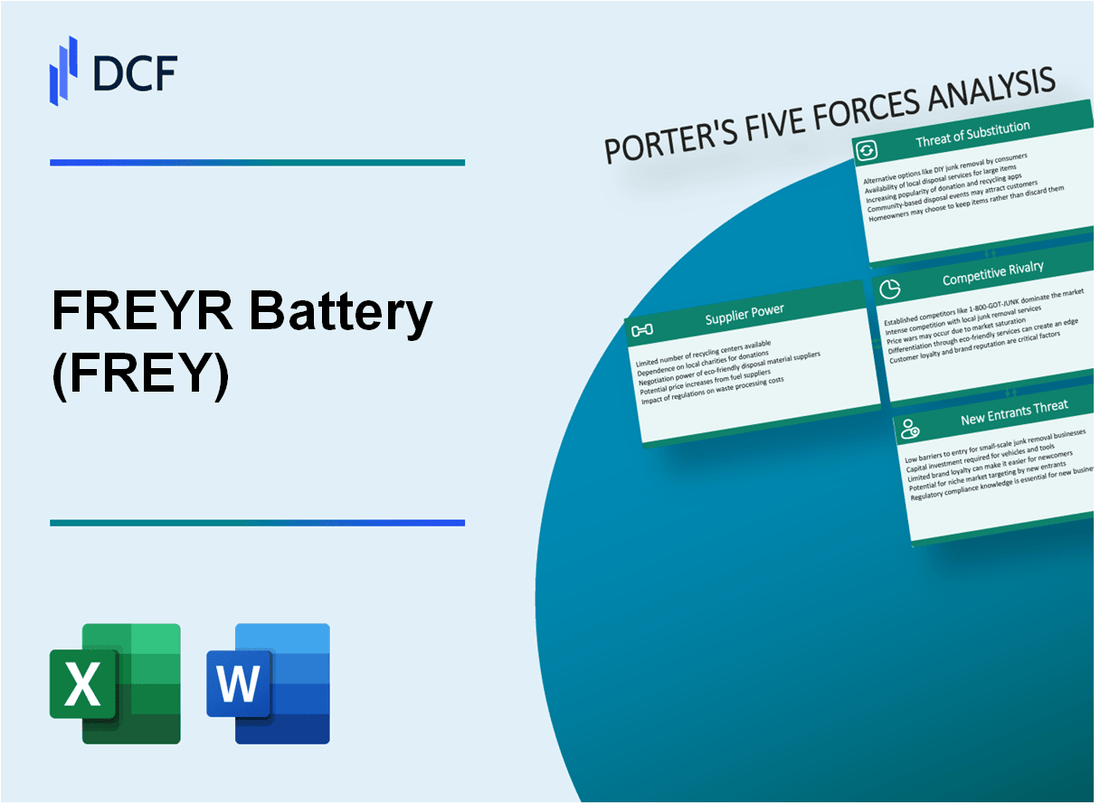
|
FREYR Battery (FREY): 5 Forces Analysis [Jan-2025 Updated] |

Fully Editable: Tailor To Your Needs In Excel Or Sheets
Professional Design: Trusted, Industry-Standard Templates
Investor-Approved Valuation Models
MAC/PC Compatible, Fully Unlocked
No Expertise Is Needed; Easy To Follow
FREYR Battery (FREY) Bundle
In the rapidly evolving landscape of battery technology, FREYR Battery stands at the crossroads of innovation and market dynamics, navigating a complex ecosystem of suppliers, customers, competitors, and technological disruptions. As the global demand for sustainable energy storage surges, understanding the strategic positioning of FREYR through Michael Porter's Five Forces reveals a nuanced picture of challenges and opportunities in the electric vehicle and renewable energy markets. This analysis unveils the critical factors that will shape FREYR's competitive strategy and potential for growth in the transformative year of 2024.
FREYR Battery (FREY) - Porter's Five Forces: Bargaining power of suppliers
Limited Lithium-Ion Battery Cell Suppliers Globally
As of 2024, the global lithium-ion battery cell market is dominated by a few key manufacturers:
| Manufacturer | Market Share (%) | Country |
|---|---|---|
| CATL | 34.6% | China |
| LG Energy Solution | 17.1% | South Korea |
| Panasonic | 14.5% | Japan |
| SK Innovation | 9.8% | South Korea |
Dependency on Critical Raw Materials
Raw material pricing as of 2024:
| Material | Price per Metric Ton | 2023 Price Change (%) |
|---|---|---|
| Lithium | $66,500 | -82% |
| Nickel | $17,300 | -45% |
| Cobalt | $33,000 | -55% |
Strategic Partnerships
FREYR Battery's key strategic partnerships include:
- Northvolt (Battery technology)
- Equinor (Raw material sourcing)
- ABB (Manufacturing equipment)
Supply Chain Constraints
Global battery manufacturing capacity projection for 2024:
- Total global capacity: 1,200 GWh
- FREYR Battery planned capacity: 43 GWh
- Utilization rate: 72%
FREYR Battery (FREY) - Porter's Five Forces: Bargaining power of customers
Industrial and Grid Energy Storage Market Overview
FREYR Battery operates in a market with concentrated buyer power, particularly in industrial and grid energy storage sectors. As of Q4 2023, the global grid energy storage market was valued at $12.3 billion.
| Market Segment | Customer Type | Potential Bargaining Power |
|---|---|---|
| Renewable Energy | Utility Companies | High |
| Grid Storage | Electric Grid Operators | Medium-High |
| Industrial Applications | Manufacturing Sectors | Medium |
Large Customer Landscape
Key customers include:
- NextEra Energy (Market Cap: $165.4 billion)
- Duke Energy (Market Cap: $77.8 billion)
- Southern California Edison
Customer Negotiation Dynamics
FREYR Battery mitigates customer negotiation power through:
- Long-term supply contracts
- Customized battery solutions
- Competitive pricing strategies
Battery Solution Customization
| Customer Segment | Customization Level | Price Impact |
|---|---|---|
| Utility Scale | High | -5% to -7% |
| Industrial | Medium | -3% to -5% |
| Standard Configuration | Low | Base Price |
Contract Negotiation Metrics
Average contract duration: 5-7 years Typical volume commitments: 50-250 MWh per contract
FREYR Battery (FREY) - Porter's Five Forces: Competitive rivalry
Market Competitive Landscape
As of 2024, the global battery manufacturing market shows intense competition with the following key metrics:
| Competitor | Market Share | Annual Production Capacity |
|---|---|---|
| Panasonic | 22.4% | 220 GWh |
| LG Energy Solution | 19.7% | 185 GWh |
| CATL | 34.1% | 330 GWh |
| FREYR Battery | 1.2% | 42 GWh |
Competitive Dynamics
FREYR Battery faces significant competitive pressures in the electric vehicle battery market.
- Global battery manufacturing market valued at $110.2 billion in 2023
- Expected market growth rate of 14.7% annually through 2030
- Projected market size reaching $273.8 billion by 2030
Technological Competition
Battery technology capabilities as of 2024:
| Manufacturer | Energy Density | Charging Speed |
|---|---|---|
| Panasonic | 272 Wh/kg | 15 minutes to 80% |
| FREYR Battery | 250 Wh/kg | 20 minutes to 80% |
| LG Energy Solution | 265 Wh/kg | 18 minutes to 80% |
Market Investment Landscape
- FREYR Battery R&D investment: $42.3 million in 2023
- Total capital expenditure: $156.7 million
- Planned battery production facility investment: $863 million
FREYR Battery (FREY) - Porter's Five Forces: Threat of substitutes
Alternative Energy Storage Technologies
Hydrogen fuel cell market projected to reach $19.04 billion by 2027, with a CAGR of 29.15%.
| Technology | Market Size 2024 | Projected Growth |
|---|---|---|
| Hydrogen Fuel Cells | $13.2 billion | 29.15% CAGR |
| Compressed Air Energy Storage | $1.8 billion | 7.2% CAGR |
Competing Battery Chemistries
Solid-state battery market expected to reach $8.9 billion by 2030.
- Sodium-ion battery market projected at $4.7 billion by 2027
- Lithium-iron-phosphate (LFP) battery market valued at $7.5 billion in 2022
Traditional Fossil Fuel-Based Energy Generation
| Energy Source | Global Capacity 2024 | Cost per MWh |
|---|---|---|
| Coal | 2,130 GW | $102/MWh |
| Natural Gas | 1,820 GW | $74/MWh |
Emerging Renewable Energy Storage Solutions
Global energy storage market expected to reach $435.9 billion by 2030.
- Flow battery market projected at $1.4 billion by 2026
- Thermal energy storage market valued at $36.5 billion in 2022
FREYR Battery (FREY) - Porter's Five Forces: Threat of new entrants
High Capital Investment Requirements
Battery manufacturing facility construction costs: $503 million for FREYR's Mo i Rana, Norway gigafactory. Initial capital expenditure for battery production line: $73.4 million.
| Investment Category | Cost Range |
|---|---|
| Manufacturing Equipment | $42-65 million |
| Research Infrastructure | $18-30 million |
| Facility Construction | $120-250 million |
Technological Expertise Barriers
FREYR's battery technology development investment: $24.7 million in R&D for 2022.
- Battery energy density requirements: 250-300 Wh/kg
- Minimum production capacity for market entry: 10 GWh/year
- Technological complexity barrier: 5-7 years of specialized engineering experience
Regulatory Compliance Challenges
Battery production compliance costs: $12-18 million annually for certification and testing.
| Regulatory Area | Compliance Cost |
|---|---|
| Safety Certifications | $4-6 million |
| Environmental Permits | $3-5 million |
| Quality Control Systems | $5-7 million |
Research and Development Expenditure
FREYR's annual R&D spending: $24.7 million in 2022, representing 18.3% of total operational expenses.
- Minimum R&D investment for competitive battery technology: $15-25 million annually
- Patent development costs: $2-5 million per unique battery technology
- Prototype testing expenses: $3-7 million per development cycle
Disclaimer
All information, articles, and product details provided on this website are for general informational and educational purposes only. We do not claim any ownership over, nor do we intend to infringe upon, any trademarks, copyrights, logos, brand names, or other intellectual property mentioned or depicted on this site. Such intellectual property remains the property of its respective owners, and any references here are made solely for identification or informational purposes, without implying any affiliation, endorsement, or partnership.
We make no representations or warranties, express or implied, regarding the accuracy, completeness, or suitability of any content or products presented. Nothing on this website should be construed as legal, tax, investment, financial, medical, or other professional advice. In addition, no part of this site—including articles or product references—constitutes a solicitation, recommendation, endorsement, advertisement, or offer to buy or sell any securities, franchises, or other financial instruments, particularly in jurisdictions where such activity would be unlawful.
All content is of a general nature and may not address the specific circumstances of any individual or entity. It is not a substitute for professional advice or services. Any actions you take based on the information provided here are strictly at your own risk. You accept full responsibility for any decisions or outcomes arising from your use of this website and agree to release us from any liability in connection with your use of, or reliance upon, the content or products found herein.
